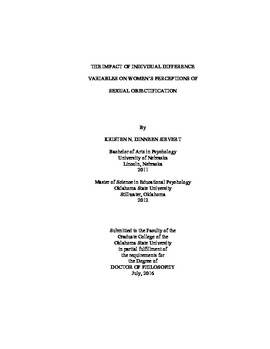| dc.contributor.advisor | Crethar, Hugh | |
| dc.contributor.author | Sievert, Kristen N. Dinneen | |
| dc.date.accessioned | 2017-02-22T22:09:06Z | |
| dc.date.available | 2017-02-22T22:09:06Z | |
| dc.date.issued | 2016-07 | |
| dc.identifier.uri | https://hdl.handle.net/11244/48799 | |
| dc.description.abstract | Sexually objectifying experiences, such as a man staring at a woman's breasts or making inappropriate sexual comments to a woman, are common occurrences in Western society (Hill & Fischer, 2008) and have been related to a variety of negative wellness outcomes for women including body image issues, disordered eating, depression, and sexual dysfunction (Calogero & Thompson, 2009; Noll & Twenge, 1998; Szymanski, & Henning, 2007; Tiggemann & Kuring, 2004). Although there is a vast amount of research regarding the consequences of sexual objectification, there has been little exploration on differences in how women perceive sexually objectifying behaviors and the way in which women come to hold such beliefs. This study attempts to fill the gap in objectification literature by exploring individual difference variables that impact women's perceptions of sexual objectification. Specifically, the study examined the extent to which contingent self-esteem, internalization of beauty ideals, hyperfemininity, traditional gender role beliefs, and past experiences of objectification predict a woman's perception of sexual objectification. Survey data collected from 199 undergraduate and graduate female University students was analyzed. Gender role beliefs and hyperfemininity were found to be significant predictors of sexual objectification, with more traditional gender role attitudes and higher levels of hyperfemininity predicting more accepting views of sexual objectification. Additionally, hyperfemininity was found to account for a significant amount of variance in sexual objectification above and beyond that accounted for by gender role beliefs, demonstrating that the two are distinct constructs from one another and provide unique and valuable information in understanding how women perceive objectifying experiences. The findings have several important implications, including providing an understanding of factors that may increase a woman's vulnerability to placing herself in objectifying contexts and recognition of specific variables to focus on in clinical contexts to minimize client endorsement of sexual objectification and participation in sexually objectifying environments. | |
| dc.format | application/pdf | |
| dc.language | en_US | |
| dc.rights | Copyright is held by the author who has granted the Oklahoma State University Library the non-exclusive right to share this material in its institutional repository. Contact Digital Library Services at lib-dls@okstate.edu or 405-744-9161 for the permission policy on the use, reproduction or distribution of this material. | |
| dc.title | Impact of individual difference variables on women's perceptions of sexual objectification | |
| dc.contributor.committeeMember | Koch, Julie | |
| dc.contributor.committeeMember | Hammer, Tonya | |
| dc.contributor.committeeMember | Miller, Bridget | |
| dc.contributor.committeeMember | Mwavita, Mwarumba | |
| osu.filename | Dinneen_okstate_0664D_13823.pdf | |
| osu.accesstype | Open Access | |
| dc.type.genre | Dissertation | |
| dc.type.material | Text | |
| thesis.degree.discipline | Educational Psychology | |
| thesis.degree.grantor | Oklahoma State University | |
